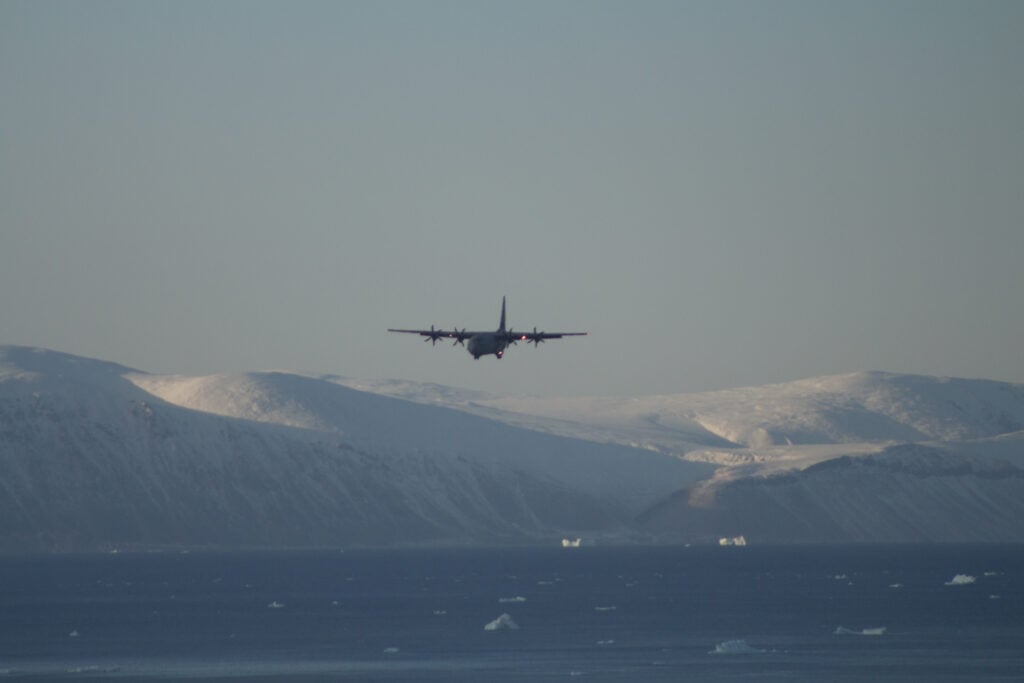
A Royal Canadian Air Force C-130 Hercules comes in on final approach to Thule AFB in Greenland. (File)
WASHINGTON: Wargames have become one of the Air Force’s key tools for implementing its year-old Arctic Strategy, with four separate series — each “with a different flavor” — being used to test new concepts and technology, says Lt. Gen. Clinton Hinote, deputy chief of staff for strategy, integration and requirements.
“We had been spending a lot of wargaming bandwidth on countering Great Powers, specifically in Europe and in the Asia Pacific. And one of the things that we felt like we did not understand as well [was] how that competition would spill over into the Arctic; how our competitors could use the Arctic in a way of doing something strategically bad for the United States and for our allies and partners,” Hinote explained during a panel sponsored by the Wilson Center’s Polar Institute.
“I believe that wargaming is one of the great focusing events that we can bring to the craft of strategy and concept development,” he added. “It really focuses everybody’s attention … because everybody wants to win.”
The Air Force — like the Navy — has been doubling down on DoD concerns that the warming environment is upping the ante in competition for Arctic resources, including oil. Congress, too, has raised red flags about increased Russian military activity in the Arctic region, as well as China’s attempts to position itself as an Arctic nation despite the facts of geography.
The service thus has been mulling its future needs in the region, eyeing new equipment buys such as more ski-equipped C-130s; prototyping new capabilities such as using commercial broadband communications satellites orbiting the poles; planning to improve bases in region; and expanding cooperation with regional allies and partners such as Norway.
Hinote said the Air Force currently is in the midst of two of the Arctic-related game series, “Arctic Engagement” and “Plan Blue,” that involve allies and partners.
“What we’re trying to do is understand the nature of the competition, as well as the range of capabilities that each of us bring to the problem,” he said. “And if the first problem is understanding what is going on in the Arctic and what others are doing, then shared awareness becomes something that is a very interesting, both objective and technological, challenge for us.”
Next up, he said is the annual “Global Engagement” game and the “Futures Game.” Both, although to a greater extent the Futures Game, are normally used by the service to “try different technologies and concepts,” he added.
“What we are trying to do with this series of four games is understand what … the dynamics are in the Arctic region, and also bring an innovative approach to what it looks like to have awareness and defense in the Arctic,” Hinote explained.
Being able to improve awareness and deterrence in the region “will probably involve a significant amount of data analytics of new technologies that allow for shared awareness and common command and control — sometimes we call that Joint All Domain Command and Control, or JADC2,” he elaborated. “And then, of course, the air and space capabilities that you need to be able to defend. So all of those are going to come into play.”
China’s new H-20 stealth bomber ‘not really’ a concern for Pentagon, says intel official
“The thing with the H-20 is when you actually look at the system design, it’s probably nowhere near as good as US LO [low observable] platforms, particularly more advanced ones that we have coming down,” said a DoD intelligence official.


























